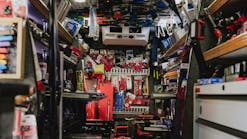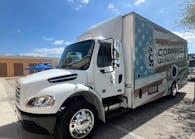Kick off the A/C season before the season actually kicks in
The secret to selling seasonal items, like air conditioning tools and equipment, is all in the timing. Because you have a fairly short window to sell seasonal tools, it’s important that you start inventorying and promoting them well before the season begins.
Think swimming trunks. In Chicago, I find swimming trunks on display in stores when even a polar bear wouldn’t wear them, but by mid-July, I’m hard pressed to find them on the clearance rack. That’s because retailers know that the bulk of seasonal sales happen early in the season -- often pre-season.
Along these same lines, here are some cool tips to boost your A/C tool sales...
Q: How do I sell an A/C RRR when all my customers already have one?
A: If you’ve ever bought a new TV, you understand the basic principle. There are many reasons a customer will want a new Air Conditioning Recovery/Recycling/Recharger (RRR): the current one is going bad, they need an extra unit to keep up with demand, or they want one with all the newest features.
Remember selling isn’t just order taking. It’s stimulating a want or fulfilling a need.
Q: How do I get a shop owner to buy an A/C unit before A/C season?
A: Plant seeds in the shop owner’s or manager’s mind. As early as April or even March, start asking him about his A/C sales: Does he want to generate more sales than last year? Is the shop tooled up to make that goal? How old is his current equipment? Does he have an RRR or just a recovery unit? Would an extra unit help the shop get more A/C jobs done in a day? Don’t nag him with questions, just ask one or two a week.
Another technique to get customers thinking about new equipment is to show them a slick new product with all the latest bells and whistles. What technician doesn’t want the latest and greatest new tool? Leave them literature. Encourage them to think about it. Follow up the next week offering to answer questions and ask for an order. Even if they don’t buy your top-of-the-line model, they will be more likely to consider an upgrade.
Remind the shop manager that vehicles with new R-1234yf refrigerant may soon be showing up at their shop. Let them know that when they’re ready for new A/C equipment you’re up to date on all the latest equipment trends. (See my June 2014 Professional Distributor story on R-1234yf at http://www.vehicleservicepros.com/article/11447605/r-1234yf-cool-profits-in-new-a-c-systems-and-tools)
Q: Do you really expect every customer to buy a new A/C RRR unit?
A: Of course not! Some customers will want to buy two.
OK, seriously, I realize not every customer wants or needs a new system. But there are always add-ons and accessories that you can promote, even if you or your competitor sold your customer a new AC RRR just last year.
I asked Frank Walker, vice president of marketing with Airsept, Inc., for some ideas of add-ons. Here are his thoughts:
Flush Tool with Sight Glass - As an A/C compressor begins to fail, it releases debris into the A/C system that can wreak havoc on other components. A flush tool with a large “sight glass” lets the technician see exiting fluid discoloration and debris in real time. Once the fluid flows clear, the system is clean.
“For an insignificant investment, a technician can get significantly more control over the flushing process,” says Walker. “Residual debris can cause premature component failure and unwanted comebacks.”
A/C Service Equipment Filter – Debris, sealant and other contaminants also can affect your customer’s equipment, causing it to fail. An add-on filter like Airsept’s Recycle Guard can prevent debris and sealants from contaminating the unit. Mark the customer’s account for an annual replacement filter (more often on heavily used units).
“In markets with many DIYers, debris from self-charging and off-the-shelf products can plug valves and degrade seals,” says Walker. “You want to help your customer protect their equipment investment.”
Heavy-Duty A/C Oil Injector - Today’s A/C systems are significantly smaller and contain much less refrigerant than in the past. This is designed to be environmentally friendlier. But it also means a technician needs to be much more precise in the amount of PAG oil that they add to the system.
“Too much oil is a bad thing,” says Walker. “It could reduce the efficiency of the refrigerant charge and affect the system's ability to absorb and shed heat.”
Note: A/C systems in hybrids are a different beast and require special repair procedures and oils. If your customers aren’t trained in it, discourage them from servicing it.
Q: OK, anything else I can sell during the A/C season?
A: Back to our analogy: If I ran a department store, I’d display sunscreen next to the swim trunks. They’re a natural fit. (I might also install a tanning bed for sun-challenged guys like me!) If you’re selling A/C tools and equipment, you should be promoting items like UV dye and additives to the shop.
Your UV dye should be certified against SAE J2297. That will work in R12, R1234a and the new R1234yf systems, says Matthew Otten, product marketing specialist with CPS Products Canada Limited, makers of the UView brand. Some dyes include additives to prevent future leaks. UView dyes include a friction reducer and anti-wear additive.
Because they’re consumable, like sunscreen, they’re also good stock-up and repeat purchase items. A quick “How are you doing on A/C supplies?” at every stop during A/C season can really add up over time.
Q: There are a lot of shop purchases. Anything a tech would buy for A/C work?
A: Your technician customers may be interested in buying UV lights and glasses.
Be sure you’re selling a true UV light that produces the proper lightwaves to actually “fluorese” the dye, says Otten. Many lights marketed for UV are actually blue lights. Although they may look brighter because they produce more visible light, they are not as effective at spotting leaks.
Sometimes selling A/C tools or accessories takes a few nudges. Just don’t stop selling until the season is over. Remember, there’s always at least one pale guy looking for swim trunks on the clearance rack on Labor Day weekend.



